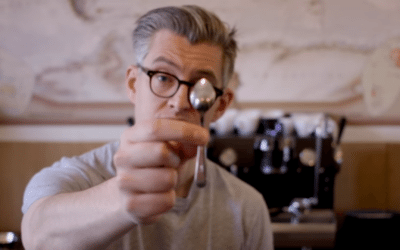The Hario V60 is a firm favorite amongst coffee enthusiasts looking for a simple and straightforward way to try out pour over brewing at home.
Available in a glass, metal, plastic, copper, or ceramic, as well as a range of sizes and colors, there truly is a V60 for everyone.
However, if you find that your V60 is regularly clogging, you’re not alone.
I’ve certainly been there – ready to make a delicious drip coffee, only to find that the V60 looks more like a swamp, with floating grounds drifting across water that simply won’t drain into the decanter.
This can be frustrating, but the good news is that it is a challenge that you can easily overcome.
What Causes Clogging?
Clogging, also commonly referred to as “choking” or “stalling”, is a common issue with all forms of manual brewing, and something that you will likely face at some point or another.
The first step towards resolving clogging is to determine what is causing it.
Here are five of the most common reasons for a clogged filter.
1. Pouring Mistakes
To brew a V60 pour over coffee, you need to line the V60 with a paper filter, wet the filter and then add the grounds to its center.
You will then create a small well in the grounds with your finger and pour your boiling water over them until they are all wet. A key thing to bear in mind during this part of the pour over technique is that you need to pour gently. Aim to pour slowly, using a soft, circular motion.
Pouring too quickly, heavily or with too much enthusiasm can excessively churn the bed of coffee grounds in the filter. This will disrupt fine particles within the grounds, which can then clog the paper filter.
The fine grounds clogging the filter act as an extra barrier for your coffee and water to pass through, extending the amount of time the coffee takes to draw down into the decanter and ruining the final brew.
2. Grinding Mistakes
We recommend that you use a burr grinder when using a V60 to create drip coffee.
Mechanical burr grinders offer a more consistent grind than other methods and can ensure that your coffee grounds are the right size to work well using the pour over technique.
If you find that your filter is regularly clogging, this could be because you are grinding your coffee beans too finely.
Blade grinders and entry-level burr grinders can produce higher levels of microparticles than semi-professional and professional grinders, which can clog the filter and cause problems.
However, this doesn’t mean that you have to go out and spend a fortune on a new grinder. Instead, simply try grinding your coffee a little more coarsely.
Please note that coarser grounds tend to have a lower extraction yield. You can counteract this by using a stronger brew ratio.
3. Low Quality Filters
There are plenty of paper filters for drip coffee available on the market.
It’s not all too surprising that many people will automatically opt for the lowest cost option they can find. But factors ranging from filter materials to the shape and size of the filter you choose can have a great impact on how easily your coffee can filter through and, as a result, the quality of your final drink.
Hario paper filters are, of course, most recommended for a V60. They are tightly woven and absorbent, which helps them to collect oils and sediment from your grounds. They are also the easiest option when it comes to cleaning up after brewing your coffee, as they can simply be picked up and disposed of.
Experiment with different filters to determine which best prevent clogging when you’re making coffee. Most people opt for Hario branded filters, but there are some good alternatives out there that work equally as well such as:
4. Dense, Light Roast Coffee
If you’re trying to brew dense, light roasted coffees in your V60, the coffee itself may be the cause of your problems. These coffees are typically grown at high altitudes, making them dense, but are then light roasted to maintain floral notes and aromas.
These coffees also tend to produce more microparticles when they are ground, as they tend to crush and shatter when hitting the burrs in your coffee grinder. These microparticles then clog the paper filter, resulting in a slower draw down and a bitter or ruined flavor.
There’s not much you can do to resolve this issue, and may simply find that you need to use alternative types of coffee in your V60. While it’s not impossible to create a good pour over, drip coffee from these beans, it is going to be difficult.
5. A Faulty or Broken V60
Finally, if you’ve reviewed all of the potential reasons highlighted above and feel that they aren’t causing your problems, you may find that your V60 is faulty or damaged.
Closely observe your V60 while you’re using it and look out for any flaws. You may find that it is cracked, misshapen or has another issue that is causing the liquid to clog rather than drawing down freely.
If your V60 is faulty, get in touch with your supplier. If it is under warranty, they may be able to replace it. If you have broken your V60, it may simply be time to invest in a new one.
Bottom Line on Fixing a Clogged V60
To fix clogging in the Hario v60, you first need to identify the issue.
The above list should give you a good starting point. Chances are, one of those five problems is causing the problem.
The key thing to take away from this article is that your V60 clogging issues are probably not a big deal.
No matter the reason for clogging, after a quick adjustment of your technique (usually grind size) you should be back to enjoying one of the best ways to brew coffee without unnecessary hassle.













0 Comments